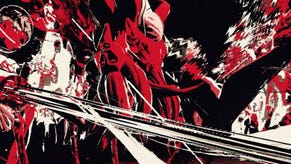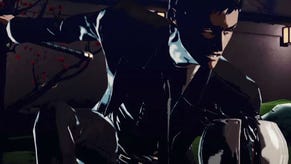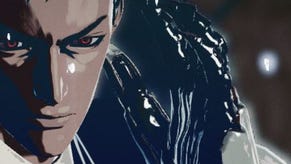Killer is Dead: video game death & then meaningful death
The ultra-violence is out in force in Killer is Dead, but Phil finds hints of something more in the latest Grasshopper Manufacture effort.
Probably the most honest thing I can say about Killer is Dead after watching the game's creative director, Shin-san, play it for 20 minutes, is that it sure as hell looks like a current-generation home console Suda 51 game. We've been spoiled by Goichi Suda's violent binge over the past few years with No More Heroes, Shadows of the Damned and Lollipop Chainsaw, and said binge continues here in a game that is just chock-full of bloodletting.
But that's not what makes it a Suda game; what does is the visual style, in which colors are muted in favor of a nearly black-and-white experience, and the imagination on display – the standard grunt enemies Shin-san was fighting, Suda said, were from the dark side of the moon, to cite one example of the madness.
Here, Suda is crafting an episodic experience. Our “hero,” Mondo Zappa, is an hitman – or "executioner", as Suda called him – and in each stage he has a target he needs to put down. Along the way, though, he will have to fight through a bunch of aliens before doing the big deed. Each of these chapters is a self-contained story, but still part of an over-arching saga that is the entire game.
I got the impression, though, that the hordes of foes you must cut through are mostly filler, and this comment Suda made to me, via a translator, is what made me think that:
“Mondo Zappa, the main character in the game, he's an executioner,” Suda emphasized when I probed him about the game's obsession with death. “What we really wanted to focus on and portray to players is the intensity of holding that sword and ending someone's life.”
What he's referring to there is most certainly not the mundane act that is fighting generic groups of enemies positioned in linear corridors, which is what much of what I saw of the game consisted of. No, he was talking about Mondo's targets, who serve as the boss for each stage.
I asked him and Shin-san, then, how they can make the deaths of these particular characters have weight when their deaths are surrounded by that of dozens of faceless, nameless bad guys. Shin-san pointed out that while I did not see it in the demonstration, these bosses are given backstories and are treated as fully fleshed-out characters, and are really acting as the villains of these individual stories
“Every boss will have their own introduction. We really give each boss a lot of character,” Shin-san said. “You don't just storm in an kill him; there's always going to be a story, and he's going to be leading you to that end, to the climax. That's how we add weight and meaning to his death.”
Though I did not get to see the introduction of a boss in the level that I watched, I did get to see his end. And it's clear that Suda and co. are at least making an attempt at assigning some depth to these executions. I may not have known who this particular character was or what kind of person he was or what he did, but his death was quite drawn out and seemed to be a pretty solemn affair.
But the fight itself, and not just the concluding cutscene, added gravitas of its own. While I expect many competent gamers will be able to sleepwalk through many of the lesser battles, this boss fight, which seemed to last hours, was no joke. Grasshopper is no stranger to the boss battler, of course, and it showed.
“You could argue that at one point we were designing the most boss fights of any game developer around in terms of the sheer number of different encounters,” Suda said, before discussing how the team would come up with the mechanics and presentation for these fights.
“We all just throw our ideas into a bin, and a lot of it is inspired not just by traditional kind of Japanese boss fights; we try to include all the elements of gameplay and then create encounters and boss fights around those.”
What results, at least in the complicated multi-stage fight I witnessed, is a struggle, and the aftermath is so uber-serious and even gloomy that I imagine it might be difficult to take great joy in your victory. I would expect relief, yes, but if Suda and Shin-san and the rest of the team do what they hoped they've done with this plot then there will be a definite lack of jumping for joy by the folks who don't skip cutscenes.
But of course that can be difficult to judge as a viewer rather than a participant. As it is, Killer is Dead appears to be run of the mill in some ways, but you can rest assured – as any fan of Suda's should know by now – that the Grasshopper Manufacture team is most certainly attempting to leave their signature on this game. You certainly won't mistake it for anybody else's game.
Killer is Dead launches on August 27, on PlayStation 3 and Xbox 360.










